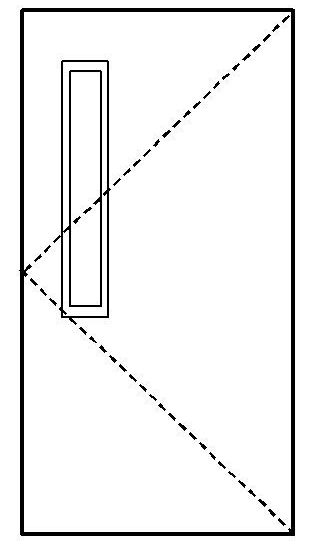 Here’s a heads-up going out to all of the detailers, architects, and door manufacturers out there…
Here’s a heads-up going out to all of the detailers, architects, and door manufacturers out there…
What do you see when you look at this door elevation? Anything unusual? –>
I’m sure there will be some debate on this because I’ve seen varying door-elevation concepts on the internet, but the way I learned about door elevations in architectural school, the single point in the door elevation indicates the hinge side of the door and the lines going to the corners are pointing to the lock edge. That seems kind of counter-intuitive, but I believe this to be typical, at least in the US.
So this door elevation is indicating that the vision panel is near the hinge edge of the door. In the Olden Days I would probably have looked at this and figured the architect made a mistake, but for classrooms this may eventually become more common than having the vision panel near the lock edge. The vision light location shown here would help prevent an intruder from breaking the glass and reaching through to turn the lever handle. Sidelights can also be positioned on the hinge side of the door for the same reason.
I wrote about classroom vision light locations in a past post, but thought it would be prudent to post a reminder, since someone contacted me about this just last week. They had supplied doors for a school project where the elevation showed this application, and it was missed (luckily it was only 2 doors!). For all of the architects reading this…I highly recommend that you note the light location when it is out of the norm, rather than relying on the dashed lines to show the hinge edge vs. lock edge of the door.
Have you worked on any school projects where the vision light location was adjusted for security reasons?
You need to login or register to bookmark/favorite this content.






In my wife’s school district all teachers are required to “black out” their sidelites with construction paper or something similar to obscure them. It would not surprise me if vision lites started going away entirely.
Hi Logan –
The vision lights are supposed to be there for supervision/oversight…personally I think it would be worse to have the lights go away considering the stats on school crime vs. active shooters in schools.
– Lori
Dumb reactionary poorly thought out move as most grown men can reach the lever from that location in a 3-0 door.
Hi Bryan –
I think it does make it more difficult to reach the hardware, especially if the light is narrow.
– Lori
I was looking into this very thing about 3 weeks ago and discovered that in Australia and New Zealand, the norm is to have the point to the latch side. I was about to order some doors and the door elevation I was given was incorrect. They did want the light on the lock side.
Hi Bob –
Yes – I found some international references showing the lines the other way.
– Lori
The light is for observation. I feel it would be better to use impact resistant glazing.
I agree with Lori, vision lights are necessary.
There is much more going on in classrooms that would require additional supervision such as bullying or even in appropriate actions by even a teacher.
I think moving the vision light to the hinge edge is a great idea and I will be making the suggestion in the future.